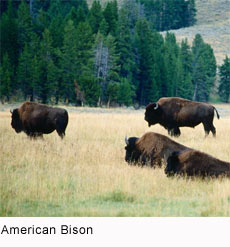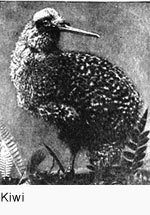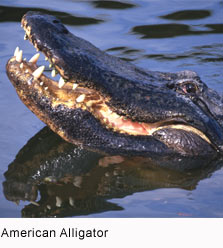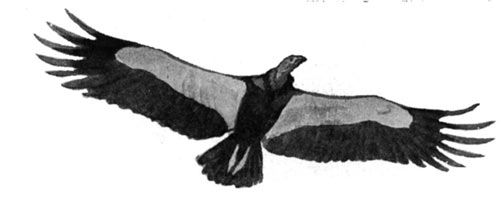 American Bison: Before the arrival of European Colonists, at least 30 million American Bison roamed North America in vast herds. Throughout the 19th century, bison were aggressively hunted for their pelts, meat (especially their tongues), and for sport. American Bison: Before the arrival of European Colonists, at least 30 million American Bison roamed North America in vast herds. Throughout the 19th century, bison were aggressively hunted for their pelts, meat (especially their tongues), and for sport.
By the turn of the century, there were only 750 surviving bison. Due to government protection and breeding programs, bison have made an impressive comeback. They now number about 80,000, but only live in parks, reserves, and private collections.
 Kiwi: While the kiwi is the cherished mascot of New Zealand and has had total legal protection since 1896, the species is in grave danger. Conservationists are working to create predator-free reserves on small islands and fenced areas on the mainland to protect the birds. Kiwi: While the kiwi is the cherished mascot of New Zealand and has had total legal protection since 1896, the species is in grave danger. Conservationists are working to create predator-free reserves on small islands and fenced areas on the mainland to protect the birds.
A program called Operation Nest Egg collects wild kiwi eggs and rears them in captivity or predator-free reserves. This program has increased chick survival rates from 5 to 85 percent!
American Alligator: Of the 23 crocodilian species, 12 are vulnerable or endangered! Humans hunt crocs for their skins (to make shoes and luggage) and some have suffered from habitat loss.
 The American Alligator was once considered endangered, but, through captive breeding programs and environmental protection plans, it has made a comeback. Crocodile conservation groups are now turning their attention to other crocodilians in need. The American Alligator was once considered endangered, but, through captive breeding programs and environmental protection plans, it has made a comeback. Crocodile conservation groups are now turning their attention to other crocodilians in need.
Black Robin: The recovery of the Black Robin population in the Chatham Islands is an internationally known conservation success story. In 1980, there were
only 5-7 black robins in the world, and only one pair was breeding. Today, the world’s Black Robin population numbers at 250—not many, but more than most would expect from a species on the edge of extinction. Success stories like these prove that humans have the power to protect endangered birds.
California Condor: While the California Condor once lived throughout the American Southwest and Mexico (and pockets of New York and Florida), there were only 21 living California Condors between 1981 and 1982. In 1987, the last free-flying wild California Condor was captured and placed in a breeding program. Thanks to several captive breeding programs, California Condor populations have risen to an estimated 200 individuals. Roughly 100 of these condors live in the wild in protected habitats.

|

